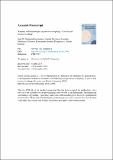Semantic web technologies in pervasive computing : a survey and research roadmap
Abstract
Pervasive and sensor-driven systems are by nature open and extensible, both in terms of input and tasks they are required to perform. Data streams coming from sensors are inherently noisy, imprecise and inaccurate, with differing sampling rates and complex correlations with each other. These characteristics pose a significant challenge for traditional approaches to storing, representing, exchanging, manipulating and programming with sensor data. Semantic Web technologies provide a uniform framework for capturing these properties. Offering powerful representation facilities and reasoning techniques, these technologies are rapidly gaining attention towards facing a range of issues such as data and knowledge modelling, querying, reasoning, service discovery, privacy and provenance. This article reviews the application of the Semantic Web to pervasive and sensor-driven systems with a focus on information modelling and reasoning along with streaming data and uncertainty handling. The strengths and weaknesses of current and projected approaches are analysed and a roadmap is derived for using the Semantic Web as a platform, on which open, standard-based, pervasive, adaptive and sensor-driven systems can be deployed.
Citation
Ye , J , Dasiopoulou , S , Stevenson , G T , Meditskos , G , Kontopoulos , E , Kompatsiaris , I & Dobson , S A 2015 , ' Semantic web technologies in pervasive computing : a survey and research roadmap ' , Pervasive and Mobile Computing , vol. 23 , pp. 1-25 . https://doi.org/10.1016/j.pmcj.2014.12.009
Publication
Pervasive and Mobile Computing
Status
Peer reviewed
ISSN
1574-1192Type
Journal article
Description
This work has been supported by the EU FP7 projects SAPERE: Self-aware Pervasive Service Ecosystems under Contract No. 256873 and Dem@Care: Dementia Ambient Care — Multi-Sensing Monitoring for Intelligent Remote Management and Decision Support under Contract No. 288199.Collections
Items in the St Andrews Research Repository are protected by copyright, with all rights reserved, unless otherwise indicated.

